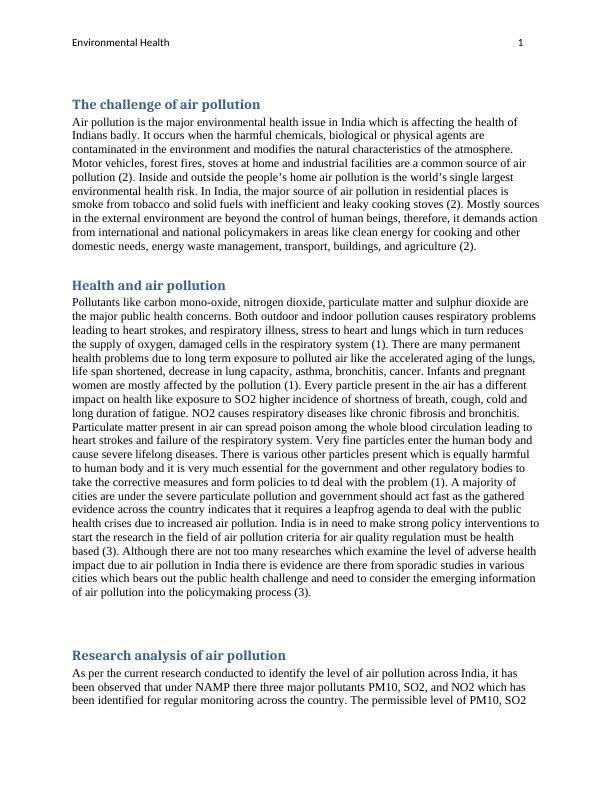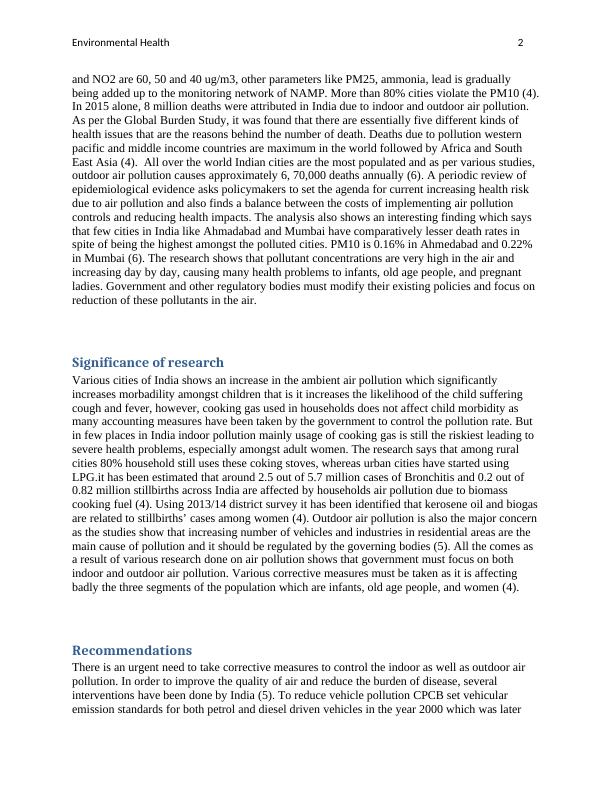Ask a question from expert
Environmental Health Assignment (Doc)
4 Pages1715 Words248 Views
Added on 2020-03-28
Environmental Health Assignment (Doc)
Added on 2020-03-28
BookmarkShareRelated Documents
Environmental Health1The challenge of air pollution Air pollution is the major environmental health issue in India which is affecting the health of Indians badly. It occurs when the harmful chemicals, biological or physical agents are contaminated in the environment and modifies the natural characteristics of the atmosphere. Motor vehicles, forest fires, stoves at home and industrial facilities are a common source of air pollution (2). Inside and outside the people’s home air pollution is the world’s single largest environmental health risk. In India, the major source of air pollution in residential places is smoke from tobacco and solid fuels with inefficient and leaky cooking stoves (2). Mostly sourcesin the external environment are beyond the control of human beings, therefore, it demands actionfrom international and national policymakers in areas like clean energy for cooking and other domestic needs, energy waste management, transport, buildings, and agriculture (2).Health and air pollutionPollutants like carbon mono-oxide, nitrogen dioxide, particulate matter and sulphur dioxide are the major public health concerns. Both outdoor and indoor pollution causes respiratory problems leading to heart strokes, and respiratory illness, stress to heart and lungs which in turn reduces the supply of oxygen, damaged cells in the respiratory system (1). There are many permanent health problems due to long term exposure to polluted air like the accelerated aging of the lungs, life span shortened, decrease in lung capacity, asthma, bronchitis, cancer. Infants and pregnant women are mostly affected by the pollution (1). Every particle present in the air has a different impact on health like exposure to SO2 higher incidence of shortness of breath, cough, cold and long duration of fatigue. NO2 causes respiratory diseases like chronic fibrosis and bronchitis. Particulate matter present in air can spread poison among the whole blood circulation leading to heart strokes and failure of the respiratory system. Very fine particles enter the human body and cause severe lifelong diseases. There is various other particles present which is equally harmful to human body and it is very much essential for the government and other regulatory bodies to take the corrective measures and form policies to td deal with the problem (1). A majority of cities are under the severe particulate pollution and government should act fast as the gathered evidence across the country indicates that it requires a leapfrog agenda to deal with the public health crises due to increased air pollution. India is in need to make strong policy interventions tostart the research in the field of air pollution criteria for air quality regulation must be health based (3). Although there are not too many researches which examine the level of adverse health impact due to air pollution in India there is evidence are there from sporadic studies in various cities which bears out the public health challenge and need to consider the emerging information of air pollution into the policymaking process (3).Research analysis of air pollutionAs per the current research conducted to identify the level of air pollution across India, it has been observed that under NAMP there three major pollutants PM10, SO2, and NO2 which has been identified for regular monitoring across the country. The permissible level of PM10, SO2

Environmental Health2and NO2 are 60, 50 and 40 ug/m3, other parameters like PM25, ammonia, lead is gradually being added up to the monitoring network of NAMP. More than 80% cities violate the PM10 (4).In 2015 alone, 8 million deaths were attributed in India due to indoor and outdoor air pollution. As per the Global Burden Study, it was found that there are essentially five different kinds of health issues that are the reasons behind the number of death. Deaths due to pollution western pacific and middle income countries are maximum in the world followed by Africa and South East Asia (4). All over the world Indian cities are the most populated and as per various studies, outdoor air pollution causes approximately 6, 70,000 deaths annually (6). A periodic review of epidemiological evidence asks policymakers to set the agenda for current increasing health risk due to air pollution and also finds a balance between the costs of implementing air pollution controls and reducing health impacts. The analysis also shows an interesting finding which says that few cities in India like Ahmadabad and Mumbai have comparatively lesser death rates in spite of being the highest amongst the polluted cities. PM10 is 0.16% in Ahmedabad and 0.22% in Mumbai (6). The research shows that pollutant concentrations are very high in the air and increasing day by day, causing many health problems to infants, old age people, and pregnant ladies. Government and other regulatory bodies must modify their existing policies and focus on reduction of these pollutants in the air.Significance of researchVarious cities of India shows an increase in the ambient air pollution which significantly increases morbadility amongst children that is it increases the likelihood of the child suffering cough and fever, however, cooking gas used in households does not affect child morbidity as many accounting measures have been taken by the government to control the pollution rate. But in few places in India indoor pollution mainly usage of cooking gas is still the riskiest leading to severe health problems, especially amongst adult women. The research says that among rural cities 80% household still uses these coking stoves, whereas urban cities have started using LPG.it has been estimated that around 2.5 out of 5.7 million cases of Bronchitis and 0.2 out of 0.82 million stillbirths across India are affected by households air pollution due to biomass cooking fuel (4). Using 2013/14 district survey it has been identified that kerosene oil and biogasare related to stillbirths’ cases among women (4). Outdoor air pollution is also the major concernas the studies show that increasing number of vehicles and industries in residential areas are the main cause of pollution and it should be regulated by the governing bodies (5). All the comes as a result of various research done on air pollution shows that government must focus on both indoor and outdoor air pollution. Various corrective measures must be taken as it is affecting badly the three segments of the population which are infants, old age people, and women (4). RecommendationsThere is an urgent need to take corrective measures to control the indoor as well as outdoor air pollution. In order to improve the quality of air and reduce the burden of disease, several interventions have been done by India (5). To reduce vehicle pollution CPCB set vehicular emission standards for both petrol and diesel driven vehicles in the year 2000 which was later

End of preview
Want to access all the pages? Upload your documents or become a member.
Related Documents
Adverse Health Effect and Particulate Matter Article 2022lg...
|13
|2564
|16
Public Healthlg...
|5
|714
|311
Health Impacts of Air Pollutionlg...
|6
|1881
|321
Introduction toEnvironmental Public Health Trackinglg...
|10
|2593
|101
Air Pollution as a Global Health Policy Issuelg...
|11
|3938
|342
Air Pollution Effects on Health - PDFlg...
|6
|1912
|141